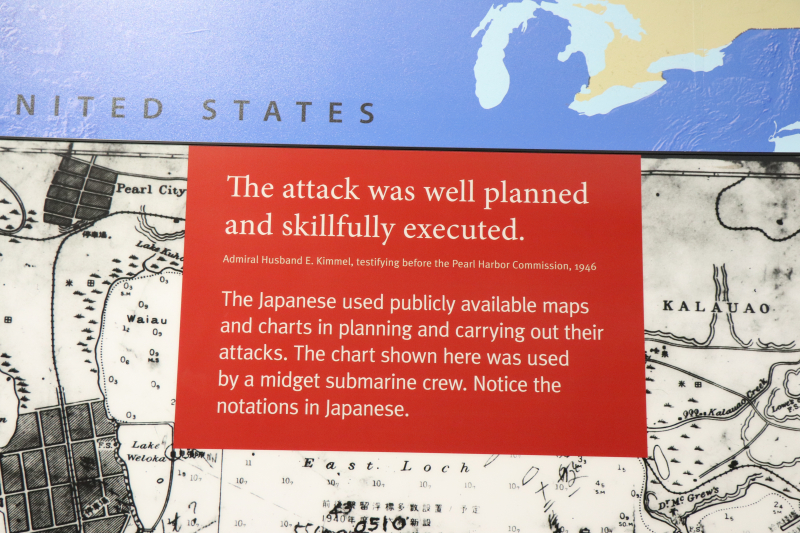I found lots of items and descriptions which were inaccurate and I didn't even know where to start. I'm writing about the U.S.'s decoding of the Japanese correspondences in this entry. The decoders of those days were exhibited in the archives. Though the U.S. had already understood the intention of Japan, i.e. the attack on the U.S., the panel read that the U.S. didn't know where the Japanese attack targeted. If their words are correct, why had all the aircraft carriers fled far off the coast of Oahu island in advance.
This exhibition section was full of excuses. The radar station in the north of Oahu island detected the signals of the upcoming Japanese military planes, but the radar personnel took them as the signals of their newly installed planes from the U.S. mainland. Was that possible? The Japanese bombers and fighters were coming from the north and the U.S. mainland is located to the east.
Let me explain the historical facts now. FDR had to make up an excuse to wage the war against Japan, who had launched and run his election campaign for the presidency making a public commitment never to join the war. That is, FDR had to force Japan to start the war the way everyone saw that Japan urged the U.S. to get involved in World War II. The U.S. had to disguise the fact that they had already caught the intention of Japan until the Japanese attack on Pearl Harbor. They had to make the Japanese attack a "surprise". As they had made up a slogan "Remember Alamo" before, they wanted a new slogan, "Remember Pearl Harbor".
Though FDR meant to allow Japan to attack first and then respond to it, unfortunately for FDR, the Japanese technique of battle was far above his thought and the damage to the U.S. Navy was catastrophic. That was his silly misjudgement. The U.S. couldn't effectively respond to the attack. The next day's attack on the Battleship Prince of Wales and its sinking off the Malay Peninsula would make his blood run cold.
The U.S. government accused the commander, Husband Edward Kimmel, of the disastrous results, and sentenced a disciplinary punishment, but the Senate approved the restoration of his reputation in 1999, more than 50 years after the war, and the House of Representatives followed next year, because it came out in the open that he had been kept away from the important information. However, the U.S. President of those days, Bill Clinton, didn't sign the resolution. I don't know why. Did he want to conceal the historical facts? I don't know if his honor was vindicated or not. If you know the result, tell me please.
I felt that the U.S. was making desperate efforts to distort the historical facts. The picture shows a map exhibited in this section, which was used by a midget submarine crew. I wrote about them here.
(Vocabulary)
make a person's blood run cold 心胆を寒からしめる
disciplinary punishment 懲戒処分
vindicate [他](フォーマル) 〈判断など〉の正しさを証明する; 〈人〉の嫌疑を晴らす
feel vindicated 報われた思いがする

http://kumo.typepad.jp/weblog/2017/12/memorial-day.html
(Apr. 11th)
無線傍受とキンメルの話
ツッコミどころだらけの史料館だが、次に暗号解読について書く。当時使われていた暗号解読器の実物が展示されていた。日本軍の暗号をほぼ完全に解読していた一方で、どこへ攻めてくるのかわからなかったと書いていたが、これも嘘。空母を港から出し遙か沖に避難させていたのはなぜなんだ?
このセクションは言い訳のオンパレード(笑)。オアフ島北部のレーダー施設で日本軍の機影をキャッチしたが、これは同日、アメリカ本土から送られてくる軍用機の機影と勘違いしたと書かれていた。方角が違うのだが。(笑)
戦争には関与しないという公約を掲げて大統領になったFDRには戦争を始める口実が必要だった。つまり、最初の一発を日本側から撃たせ、アメリカは仕方なく戦争に巻き込まれてしまったことにする必要があったのだ。そのためには、日本軍が攻撃をしてくるまでアメリカは日本の意図を知らなかったことにしなければならなかった。『リメンバーアラモ』よろしく『リメンバーパールハーバー』というスローガンを造らねばならなかったからだ。
ただ、日本の戦闘技術がFDRの浅知恵を遙かに超えたレベルにあったことがFDRの誤算だった。アメリカ軍は日本の攻撃が始まった後、反撃らしい反撃を出来なかったのだ。翌日のマレー沖でのプリンスオブウェールズの撃沈もまた彼の心胆を寒からしめたことだろう。
被害の大きさを重く見たアメリカ軍は司令官のキンメルを懲戒処分としたが、情報を隠されていたことが判明し、1999年5月、名誉回復決議が上院で採択され、翌年10月、下院でも名誉回復決議採択された。が、時の大統領ビル・クリントンは署名を拒否。最終採決は次代ジョージ・W・ブッシュまで持ち越されたが、ブッシュも署名をしていない。史実を隠したいのだろうか?現在どうなっているのかはちょっとわからない。知っている人がいたら教えて欲しい。
また、航空機による攻撃に加えて真珠湾から逃げ出してくる船を沈めるために特攻攻撃が準備されていた。彼らの訓練は僕のふるさとで行われていた。彼らが実際に使った地図が展示されていたので載せておく。本当の『戦争への道』を誤魔化すために米国政府が涙ぐましい努力をしていることが憐れに見えた。
Recent Comments